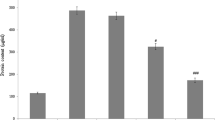Abstract
Acute zymosan-induced peritonitis in rats produces lung inflammation and lipid peroxidation. The effect of this process on plasma and lung tissue ascorbic acid was determined, as was the effect of infusing 150 mg/kg of ascorbic acid immediately after zymosan on the degree of lung insult. Ascorbic acid levels were significantly decreased in plasma and lung tissue at 24 h after zymosan, and lung tissue conjugated diene and neutrophil content was also significantly increased. Vitamin C infusion increased postzymosan plasma levels by 50% over normal control levels. However, lung tissue ascorbic acid was still decreased, and no decrease in the lung injury process was noted. Added ascorbic acid also did not prevent a decrease in plasma vitamin E with the peritonitis. We conclude that the amount of ascorbic acid given in this study did not diminish the lung oxidant inflammatory changes. An insufficient dose or inadequate time for plasma ascorbic acid to equilibrate with the lung cytosol are possible explanations for the lack of attenuation of lung oxidant stress.
Similar content being viewed by others
References
Machlin, L., andA. Bendich. 1987. Free radical tissue damage: Protective role of antioxidant nutrients.FASEB J. 7:441–445.
Krinsky, N. 1988. Membrane antioxidants.Ann. N.Y. Acad. Sci. 551:17–33.
Bast, A., R. Gurde, M. Haenan, andC. Doelman. 1991. Oxidants and antioxidants: State of the art.Am. J. Med. 91:2–11.
Niki, E. 1991. Action of ascorbic acid as a scavenger of active and stable oxygen radicals.Am. J. Clin. Nutr. 54:1119–1124.
Niki, E. 1987. Interaction of ascorbate andα tocopherol.Ann. NY. Acad. Sci. 498:186–198.
Jonas, E., A. Dwenger, andA. Hager. 1993. In vitro effect of ascorbic acid on neutrophilendothelial cell interaction.J. Biolumin. Chemilumin. 8:15–20.
Oberriter, H., B. Glatthaar, U. Moser, andK. Schmidt. 1986. Effect of functional stimulation on ascorbate content in phagocytes under physiological and pathological conditions.Int. Arch. Allergy Appl. Immunol. 81:46–50.
Dwenger, A., M. Funck, B. Leuken, G. Schweitzer, andU. Lehmann. 1992. Effect of ascorbic acid on neutrophil functions and hypoxanthine/xanthine oxidase generated oxygen derived radicals.Eur. J. Clin. Chem. Clin. Biochem. 30:187–191.
Louw, J., A. Werbeck, M. Louw, J. Theums, W. Kotze, R. Cooper, andD. Labadariocis. 1992. Blood vitamin concentration during the acute phase response.Crit. Care Med. 20:934–940.
Maderazo, E., G. Woronick, N. Hickingbotham, E. Mercier, L. Jacobs, andH. Bhagavan. 1990. Additional evidence of autooxidation as a possible mechanism of neutrophil locomotory dysfunction in blunt trauma.Crit. Care Med. 18:141–147.
Iwin, T., D. Chattopadhyay, andA. Smythe. 1978. Ascorbic acid requirements in post operative patients.Surg. Gynecol. Obstet. 147:49–52.
Fang, C., M. Peck, J. Alexander, G. Babcock, andG. Warden. 1990. The effect of free radical scavengers on outcome after infection in burned mice.J. Trauma 4:453–456.
Reilly, P., H. Schiller, andG. Bulkley. 1991. Pharmacologic approach to tissue injury mediated by free radicals and other reactive oxygen metabolites.Am. J. Surg. 161:488–504.
Frei, B., R. Stocker, L. England, andB. Ames. 1990. Ascorbate: The most effective antioxidant in human blood plasma.Adv. Exp. Med. Biol. 264:155–163.
Hemila, H. 1992. Vitamin C and the common cold.Br. J. Nutr. 67:3–16.
Nowak, D., G. Prascka, A. Antczak, andT. Pietras. 1991. Effect of ascorbic acid on hydroxyl radical generation by chemical, enzymatic, and cellular systems.Biomed. Biochem. Acta 50:265–272.
Demling, R.H., R. Daryani, C. Campbell, andC. Lalonde. 1993. The effect of acute nonbacterial dependent peritonitis on lung and liver oxidant stress and antioxidant activity.Surgery 114:571–578.
Goris, R., J. Nuytinck, W. Boekholtz, I. Bebber, andP. Shilling. 1986. Multiple organ failure and sepsis without bacteria: an experimental model.Arch. Surg. 121:897–901.
Fry, J., G. Smith, M. McGrath, E. Speijers, andJ. Allen. 1993. Plasma and tissue concentrations of alpha-tocopherol during Vitamin E depletion in sheep.Br. J. Nutr. 69:225–232.
Recknagel, R., andE. Glende. 1984. Spectrophotometric detection of lipid conjugated dienes.Methods Enzymol. 105:331–337.
Omaye, S., J. Turnbull, andH. Sauberlich. 1979. Selected methods for determination of ascorbic acid in animal cells, tissues, and fluids.Methods Enzymol. 62:3–11.
Lehman, R.W. 1954. Determination of vitamin E.In Methods of Biochemical Analysis, Volume 1. D. Glick, editor. Interscience Publishers, New York. 153–187.
Anderson, R. 1991. Assessment of the roles of vitamin C, vitamin E, andβ-carotene in the modulation of oxidant stress mediated by cigarette smoke-activated phagocytes.Am. J. Clin. Nutr. 53:358–361.
Matsuda, T., H. Tanaka, M. Hanumadass, R. Gayle, H. Yirasa, H. Abcarian, H. Matsuda, andH. Reyes. 1992. Effects of high dose vitamin C administration on post burn microvascular fluid and protein flux.J. Burn Care Rehab. 13:560–568.
Matsuda, T., H. Tanaka, S. Williams, M. Hanumadass, H. Abcarian, andH. Reyes. 1991. Reduced fluid requirement for resuscitation of third degree burns with high dose vitamin C.J. Burn Care Rehab. 12:525–532.
Mohsenin, V. 1991. Lipid peroxidation and anti-elastase activity in the lung under stress: Role of antioxidant defenses.J. Appl. Physiol. 70:1456–1462.
Ward, P., J. Warren, andK. Johnson. 1988. Oxygen radicals, inflammation, and tissue injury.Free Rad. Biol. Med. 5:403–408.
Till, G., L.Guilds, M.Mahrougui, and P.Ward. Role of xanthine oxidase in thermal injury of skin.Am. J. Pathol. 135:195–202.
Demling, R.H., andC. Lalonde. 1990. Early post burn lipid peroxidation: Effect of ibuprofen and allopurinol.Surgery 107:85–90.
Hemila, H., P. Roberts, andM. Wikstrom. 1985. Activated polymorphonuclear leukocytes consume vitamin C.FEBS Lett. 178:25–30.
Author information
Authors and Affiliations
Additional information
Supported by NIH GM36428.
Rights and permissions
About this article
Cite this article
Demling, R., Ikegami, K., Picard, L. et al. Administration of large doses of vitamin C does not decrease oxidant-induced lung lipid peroxidation caused by bacterial-independent acute peritonitis. Inflammation 18, 499–510 (1994). https://doi.org/10.1007/BF01560697
Issue Date:
DOI: https://doi.org/10.1007/BF01560697




